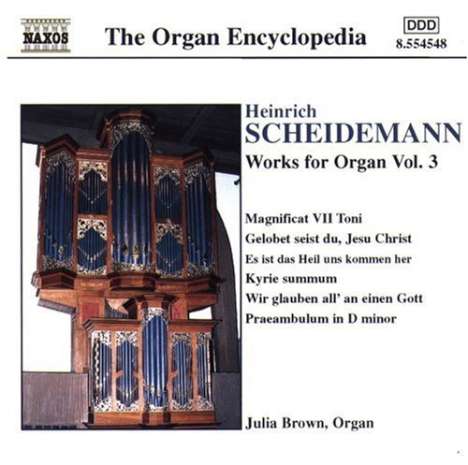Heinrich Scheidemann: Sämtliche Orgelwerke Vol.3 auf CD
Sämtliche Orgelwerke Vol.3
Herkömmliche CD, die mit allen CD-Playern und Computerlaufwerken, aber auch mit den meisten SACD- oder Multiplayern abspielbar ist.
- Künstler:
- Julia Brown / Orgel Lutheran Church Eugene Oregon
- Label:
- Naxos
- Aufnahmejahr ca.:
- 1999
- Artikelnummer:
- 3557828
- UPC/EAN:
- 0636943454824
- Erscheinungstermin:
- 5.3.2001
- Serie:
- Naxos Organ Encyclopedia
Das Werk Heinrich Scheidemanns nimmt in Quantität, Qualität und historischer Bedeutung die dominierende Stellung in der norddeutschen Orgelmusik der ersten Hälfte des siebzehnten Jahrhunderts ein. Scheidemann wurde um 1595 als Sohn des Organisten David Scheidemann geboren. Der junge Heinrich reiste 1611 nach Amsterdam, um bei Sweelinck drei Jahre lang zu studieren. Im Jahr 1625 trat er die Nachfolge seines Vaters als Organist an der Katharinenkirche in Hamburg an, wo er auch Schreiber wurde, und blieb dort bis zu seinem Tod im Jahr 1663. Viele deutsche Organisten studierten bei Sweelinck, in der Tat war der Meister in Hamburg als "der Organistenbauer" bekannt. Obwohl in Deutschland bereits um die Jahrhundertwende eine Orgelschule florierte, markierte die Arbeit von Sweelincks Schülern den Beginn der großen Periode der norddeutschen Orgelmusik, die sich über das gesamte siebzehnte Jahrhundert erstreckte.
Mittes des 17. Jahrhunderts hatte sich Hamburg zu einem der wohlhabendsten und reichsten Finanz- und Kulturzentren Nordeuropas entwickelt. Es war eine kosmopolitische, fortschrittliche Stadt mit einem etablierten Musikleben. Die Hamburger Orgeln waren ein wichtiges Symbol für den Wohlstand und die Macht der freien Hansestadt. Scheidemann war achtunddreißig Jahre lang Organist an St. Katharina, einer Kirche, die mit ihren 56 Ranks über vier Manuale und Pedal eine der schönsten Orgeln Norddeutschlands beherbergte. Scheidemann assimilierte Sweelincks Sprache und kombinierte die Polyphonie und Virtuosität seines Meisters mit anderen Elementen, was zu einem neuen, eigenständigen Stil führte.
Product Information
In quantity, quality and historical significance the work of Heinrich Scheidemann occupies the dominant position in North German organ music of the first half of the seventeenth century. Scheidemann was born around 1595, the son of the organist David Scheidemann. The young Heinrich travelled to Amsterdam in 1611 to study with Sweelinck for three years. In 1625 he succeeded his father as organist at St. Catherine's Church in Hamburg where he also became the clerk, and remained there until his death in 1663. Many German organists studied with Sweelinck, in fact, the master was known in Hamburg as 'the organist maker'. Although a school of organ-playing had already flourished in Germany at the turn of the seventeenth century, the work of Sweelinck's pupils marked the beginning of the great period of North German organ music that lasted throughout the seventeenth century.
By the mid-seventeenth century, Hamburg had become one of the most prosperous and wealthy financial and cultural centres in Northern Europe. It was a cosmopolitan, progressive town with an established musical life. The Hamburg organs were an important symbol of the prosperity and power of the free Hanse city. Scheidemann was organist for thirty eight years at St. Catherine's, a church that housed one of the most beautiful organs in Northern Germany, with its 56 ranks over four manuals and pedal. Scheidemann assimilated Sweelinck's language, combining his master's polyphony and virtuosity with other elements, resulting in a new, independent style.
Disk 1 von 1 (CD)
-
1 Praeambulum in D minor, WV 36
-
2 Kyrie summum: Kyrie
-
3 Kyrie summum: Christe
-
4 Kyrie summum: Kyrie ultimum
-
5 Verbum caro factum est
-
6 Jesus Christus, unser Heiland, der von uns II
-
7 Es ist das Heil uns kommen her: Primus versus
-
8 Es ist das Heil uns kommen her: Secundus versus
-
9 Canzona in G major
-
10 Gelobet seist du, Jesu Christ, WV 60: Primus versus
-
11 Gelobet seist du, Jesu Christ, WV 60: Secundus versus
-
12 Gott sei gelobet und gebenedeiet
-
13 Herzlich lieb hab ich dich, o Herr
-
14 Magnificat Vii Toni: Primus Versus
-
15 Magnificat Vii Toni: Secundus Versus
-
16 Magnificat Vii Toni: Tertius Versus
-
17 Magnificat Vii Toni: Quartus Versus
-
18 Jesu, wollst uns weisen
-
19 Vater Unser Im Himmelreich Iii
-
20 Praeambulum in F major, WV 39
-
21 Ego sum panis vivus
-
22 Wir glauben all' an einen Gott, WV 29: Primus versus
-
23 Wir glauben all' an einen Gott, WV 29: Secundus versus
-
24 Praeambulum in D minor, WV 32
Mehr von Heinrich Scheid...






